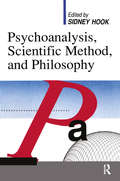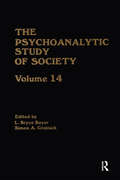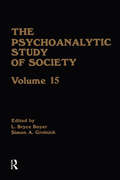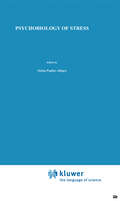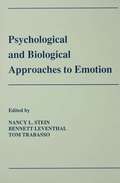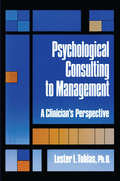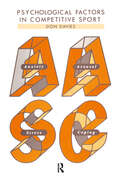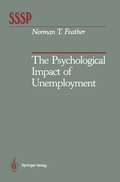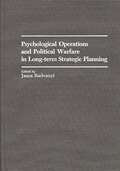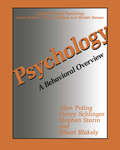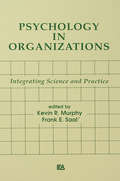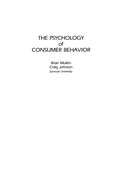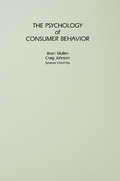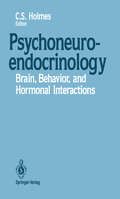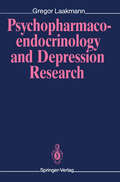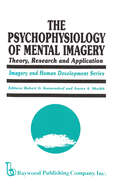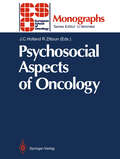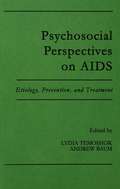- Table View
- List View
Psychoanalysis, Scientific Method and Philosophy
by Sydney HookThis by now well-known pioneering dialogue on Freudian analysis is concerned not with therapeutic implications, individual or social, of psychoanalysis or of any other brand of psychology, but solely with the status of psychoanalysis as a scientific theory. Matching talents with a distinguished group of philosophers and social scientists, psychoanalysts made their claims and willingly subject them to the methodological scrutiny common to the sciences and the philosophy of science. This book records one of the few times in the United States that a distinguished group of psychoanalysts met with an equally distinguished group of philosophers of science in a free, critical interchange of view on the scientific status of the field. While a sense of the event’s excitement is captured here, it also had clear results, such as an expanded notion of psychoanalysis as a scientific theory, and a clear realization that certain elements in psychoanalysis are substantially beyond the boundaries of causal inference or the rules of logic. Two opening statements by Heinz Hartmann and Ernest Nagel set the tone for the debate and discussion that followed. These are followed by social scientific statements of Abram Kardiner, Ernest van den Haag, and Alex Inkeles, followed by the philosophers Morris Lazerowitz, Donald C. Williams, and Anthony Flew. Such distinguished scholars as Adolf Grunbaum, Michael Scriven, Gail Kennedy, Arthur Pap, Philipp Frank. Arthur C. Danto, Max Black and others, round out this pioneering effort in the literature of intellectual combat. Sidney Hook applies to his vision of psychoanalysis the same compelling rigor he applied to other would-be advocates of a science beyond ordinary scientific method or safeguards. He nonetheless points out that even therapeutic success is not the last word, but must itself be tested on a variety of measures: statistical no less than analytical. This remains a courageous and disturbing work, one that commands attention among practicing psychiatrists, psychoanalysts—and their would-be patients.
The Psychoanalytic Study of Society, V. 14: Essays in Honor of Paul Parin
by L. Bryce Boyer Simon A. GrolnickVolume 14 includes chapters on the psychoanalysis of political commitment (P. Parin); Jews and homosexuals as strangers (P. Parin); the analogous tasks of the psychoanalyst and the ethnographer (M. Gehrie); cultic elements in early Christianity (W. Meissner); Jewish apocalyptists (D. Merkur); creationist resistance to evolution (R. Graber & L. McWhorter); sacred objects and transitional phenomena in aboriginal Central Australia; and a review of the contributions of Paul Parin (D. Freeman).
The Psychoanalytic Study of Society, V. 14: Essays in Honor of Paul Parin
by L. Bryce Boyer Simon A. GrolnickVolume 14 includes chapters on the psychoanalysis of political commitment (P. Parin); Jews and homosexuals as strangers (P. Parin); the analogous tasks of the psychoanalyst and the ethnographer (M. Gehrie); cultic elements in early Christianity (W. Meissner); Jewish apocalyptists (D. Merkur); creationist resistance to evolution (R. Graber & L. McWhorter); sacred objects and transitional phenomena in aboriginal Central Australia; and a review of the contributions of Paul Parin (D. Freeman).
The Psychoanalytic Study of Society, V. 15: Essays in Honor of Melford E. Spiro
by L. Bryce Boyer Simon A. GrolnickVolume 15 features Melford Spiro's "Culture and Human Nature" and "The internalization of Burmese Gender Identity" along with an interview of Spiro by B. Kilbourne and S. Bolle. Additional topics include children's fantasy life in Papua New Guinea (F. Poole); a psychoanthropological approach to Kagwahiv food taboos (W. Kracke); an ethnological and Rorschach study of three groups of Australian aborigines (R. Boyer et al.); a consideration of the "trickster" in relation to issues of sublimation and psychosocial development; and a review of Bettelheim's contribution to anthropology (R. Paul).
The Psychoanalytic Study of Society, V. 15: Essays in Honor of Melford E. Spiro
by L. Bryce Boyer Simon A. GrolnickVolume 15 features Melford Spiro's "Culture and Human Nature" and "The internalization of Burmese Gender Identity" along with an interview of Spiro by B. Kilbourne and S. Bolle. Additional topics include children's fantasy life in Papua New Guinea (F. Poole); a psychoanthropological approach to Kagwahiv food taboos (W. Kracke); an ethnological and Rorschach study of three groups of Australian aborigines (R. Boyer et al.); a consideration of the "trickster" in relation to issues of sublimation and psychosocial development; and a review of Bettelheim's contribution to anthropology (R. Paul).
Psychobiology of Stress (NATO Science Series D: #54)
by AlbertoOliverio StefanPuglisi-AllegraFrom a historical point of view the first studies on the response of the organism to stressful situations in general, and on the psychobiology of stress in particular, are probably those of Cannon and de la Paz, the physiologists who showed in 1911 that the adrenal medulla and the sympathetic system are involved in emergency situations. Cannon noted that the venous blood of cats frightened by barking dogs contained adrenaline, a response of the organism which was prevented by adrenalectomy or by section of the splanchnic nerve innervating the adrenal medulla. Cannon suggested that the adrenal medulla was acting in concert with the sympathetic nervous system, so that both systems were activated during stress. The role of the sympathetic system in response to stressful events was later emphasized by the experiments carried out by Maickel et al. (1967) and by Mason (1968): these authors clearly showed that stressors activate the sympathetic system causing it to release adrenaline and noradrenaline. This line of research may be contrasted with that carried out by Hans Selye, centered on of the adrenal cortex in the stress response. Selye's findings and theories originated the role the so-called hypothalamic - pituitary - adrenal cortex (HPA) model of stress: in short, during stress adrenocorticotropic hormone is released from cells of the anterior pituitary and elicits secretion of glucocorticoids from the adrenal cortex.
Psychological and Biological Approaches To Emotion
by Nancy L. Stein Bennett Leventhal Tom TrabassoThe outgrowth of a University of Chicago conference on the psychological and biological bases of behavior, this unique collection of papers integrates the biological consideration of emotion with current psychological approaches. As such, it includes studies of the coping process associated with emotion as well as those that focus on the appraisal process giving rise to emotion. The book approaches emotion from cognitive, developmental, and biological systems and psychopathological perspectives. Theories on the cognitive, biological, and developmental bases for interpreting, representing, and reacting to emotional situations are proposed. In addition, new studies on issues and questions regarding the roles of cognition, language, brain lateralization, socialization, psychopathology, and coping with affect are presented.
Psychological and Biological Approaches To Emotion
by Nancy L. Stein Bennett Leventhal Thomas R. TrabassoThe outgrowth of a University of Chicago conference on the psychological and biological bases of behavior, this unique collection of papers integrates the biological consideration of emotion with current psychological approaches. As such, it includes studies of the coping process associated with emotion as well as those that focus on the appraisal process giving rise to emotion. The book approaches emotion from cognitive, developmental, and biological systems and psychopathological perspectives. Theories on the cognitive, biological, and developmental bases for interpreting, representing, and reacting to emotional situations are proposed. In addition, new studies on issues and questions regarding the roles of cognition, language, brain lateralization, socialization, psychopathology, and coping with affect are presented.
Psychological Consulting To Management: A Clinician's Perspective
by Lester L. TobiasFirst published in 1990. Routledge is an imprint of Taylor & Francis, an informa company.
Psychological Consulting To Management: A Clinician's Perspective
by Lester L. TobiasFirst published in 1990. Routledge is an imprint of Taylor & Francis, an informa company.
Psychological Factors In Competitive Sport
by Don Davies Malcolm ArmstrongFirst published in 1989. This book explains the importance of psychological factors for achievement and performance in competitive sport. It deals with the development of ability, maximization of performance in competition, emotional health, social adjustement and general well being of the participants in sport. The two main aims are firstly to select and outline ways in which young people can learn to become highly skilled and well adjusted sportsmen and secondly to describe the techniques by which players, having become highly skilled, can perform consistently well under pressure or stress. This book is based on tried and tested methods in teaching and on extensive research findings in the field of sport psychology. There is a strong bias towards the practical and most chapters contain specific guidelines to be followed and detailed practices to be undertaken, making it ideal as a practical text for teachers, coaches or as an aid to self-improvement in the competitor.
Psychological Factors In Competitive Sport
by Don Davies Malcolm ArmstrongFirst published in 1989. This book explains the importance of psychological factors for achievement and performance in competitive sport. It deals with the development of ability, maximization of performance in competition, emotional health, social adjustement and general well being of the participants in sport. The two main aims are firstly to select and outline ways in which young people can learn to become highly skilled and well adjusted sportsmen and secondly to describe the techniques by which players, having become highly skilled, can perform consistently well under pressure or stress. This book is based on tried and tested methods in teaching and on extensive research findings in the field of sport psychology. There is a strong bias towards the practical and most chapters contain specific guidelines to be followed and detailed practices to be undertaken, making it ideal as a practical text for teachers, coaches or as an aid to self-improvement in the competitor.
The Psychological Impact of Unemployment (Springer Series in Social Psychology)
by Norman T. FeatherThis book is concerned with the psychological effects of unemployment. In writing it I had two main aims: (1) to describe theoretical approaches that are relevant to understanding unemployment effects; and (2) to present the re sults of studies from a program of research with which I have been closely involved over recent years. In order to meet these aims I have organized the book into two main parts. I discuss background research and theoretical approaches in the first half of the book, beginning with research concerned with the psychological effects of unemployment during the Great Depression and continuing through to a dis cussion of more recent contributions. I have not attempted to review the liter ature in fine detail. Instead, I refer to some of the landmark studies and to the main theoretical ideas that have been developed. This discussion takes us through theoretical approaches that have emerged from the study of work, employment, and unemployment to a consideration of wider frameworks that can also be applied to further our understanding of unemployment effects.
Psychological Operations and Political Warfare in Long-term Strategic Planning
by Janos RadvanyiWritten by a group of distinguished security experts, these eight previously unpublished papers focus on the hostile actions of the Soviet Union against the West in the form of psychological operations, power politics, and blackmail. Addressing military professionals, strategists, and international security specialists, the contributors examine the most effective measures the United States and its allies can take to counteract such measures. This is particularly important in the Gorbachev era, when Western security is perhaps more than ever dependent upon knowledge of Soviet psychological operations and political warfare. The book also explores the background of East European resistance to Soviet dominance and the subsequent Soviet countermeasures. Wide-ranging in coverage, the papers explore psychological operation in the United States, Poland, West Germany, France, and Latin America.Following the editor's introduction to psychological operations, the contributors address such topics as the history and future of U.S. military psychological operations, new thinking and influence activities in the Gorbachev era, terrorism as a political strategy, and contemporary insurgent political and psychological warfare. A case study of the Polish experience illustrates communist regimes' psychological warfare against their own societies. The remaining papers discuss psychological operations and political warfare in long-term U.S. strategic planning, the French experience with Soviet hostile actions, and the argument that psychological warfare is no longer necessary in the age of perestroika and glasnost. The contributors are united in their belief that psychological operations and political warfare will not be eliminated by the sweeping changes affecting the Soviet Union and that the Western democracies are by their very nature particularly vulnerable to such operations. However, given the changing nature of external threats to the West, the contributors call for a reevaluation of strategy in the area of psychological operations, political warfare, and low intensity conflict.
Psychology: A Behavioral Overview (Nato Science Series B:)
by Alan Poling Henry Schlinger Stephen Starin Elbert BlakelyPsychology: A Behavioral Overview is an introductory text with an orienting per spective that is frankly behavioral rather than eclectic. This focus is made quite clear in the first chapter of the book, but in the remainder it also becomes clear that such a focus permits coverage of most of the topics found in the more common introductory text. Actually, the next five chapters (dealing with psy chology as a scienc~, methodology, evolution, physiology, and learning) are in many ways comparable to the treatments provided in more eclectic introductory texts. The behavioral focus and the departure from traditional approaches be come most significant in the last six chapters which deal with traditional psycho logical topics (e. g. , language, child development, and personality)-but deal with them systematically in terms of the concepts and principles introduced in the chapters on evolution and physiology, and especially in the chapter on learning. Using the concepts provided early in the text to interpret complex aspects of human behavior provides valuable justification for those concepts, as well as an opportunity for improved understanding of them. Although students will not make extensive contact with the variety of the oretical approaches found in the typical text, they will become especially compe tent in the use of behavioral concepts and principles to interpret and understand many of the topics of traditional importance in psychology.
Psychology in Organizations: integrating Science and Practice (Applied Psychology Series)
by Kevin R. Murphy Frank E. SaalThis book deals with two key questions. First, is there a firm scientific basis for the major applications of psychology in organizations? Second, does the practice of psychology in organizations contribute in any meaningful way to psychological research? This text attempts to answer these questions by describing some of the unique ways in which Industrial/Organizational (I/O) psychologists integrate science and practice in applying psychology in organizations. The editors of this volume believe that there is great potential for the effective interplay of science and practice in I/O psychology. Aware, however, that much work must still be done before a truly effective integration can be achieved and maintained, they have created a text that offers specific suggestions for improvement as well as many examples of successful integration. Psychology in Organizations explores the unique relationship between science and practice within industrial/organizational psychology. The contributors seek to answer two main questions: * Is there a firm scientific basis for the major applications of psychology in organizations? * Does the practice of psychology in organizations contribute in any meaningful way to psychological research? After an initial examination of the industrial/organizational psychologist as a scientist and practitioner, Psychology in Organizations looks at specific roles played in such issues as job performance and productivity, sexual harassment, drug abuse, and drug testing. A final chapter looks at both the past and future of the field and suggests future applications.
Psychology in Organizations: integrating Science and Practice (Applied Psychology Series)
by Kevin R. Murphy Frank E. SaalThis book deals with two key questions. First, is there a firm scientific basis for the major applications of psychology in organizations? Second, does the practice of psychology in organizations contribute in any meaningful way to psychological research? This text attempts to answer these questions by describing some of the unique ways in which Industrial/Organizational (I/O) psychologists integrate science and practice in applying psychology in organizations. The editors of this volume believe that there is great potential for the effective interplay of science and practice in I/O psychology. Aware, however, that much work must still be done before a truly effective integration can be achieved and maintained, they have created a text that offers specific suggestions for improvement as well as many examples of successful integration. Psychology in Organizations explores the unique relationship between science and practice within industrial/organizational psychology. The contributors seek to answer two main questions: * Is there a firm scientific basis for the major applications of psychology in organizations? * Does the practice of psychology in organizations contribute in any meaningful way to psychological research? After an initial examination of the industrial/organizational psychologist as a scientist and practitioner, Psychology in Organizations looks at specific roles played in such issues as job performance and productivity, sexual harassment, drug abuse, and drug testing. A final chapter looks at both the past and future of the field and suggests future applications.
The Psychology of Consumer Behavior
by Brian Mullen Craig JohnsonAfter years of study in the area of consumer behavior, Mullen and Johnson bring together a broad survey of small answers to a big question: "Why do consumers do what they do?" This book provides an expansive, accessible presentation of current psychological theory and research as it illuminates fundamental issues regarding the psychology of consumer behavior. The authors hypothesize that an improved understanding of consumer behavior could be employed to more successfully influence consumers' use of products, goods, and services. At the same time, an improved understanding of consumer behavior might be used to serve as an advocate for consumers in their interactions in the marketplace.
The Psychology of Consumer Behavior
by Brian Mullen Craig JohnsonAfter years of study in the area of consumer behavior, Mullen and Johnson bring together a broad survey of small answers to a big question: "Why do consumers do what they do?" This book provides an expansive, accessible presentation of current psychological theory and research as it illuminates fundamental issues regarding the psychology of consumer behavior. The authors hypothesize that an improved understanding of consumer behavior could be employed to more successfully influence consumers' use of products, goods, and services. At the same time, an improved understanding of consumer behavior might be used to serve as an advocate for consumers in their interactions in the marketplace.
Psychoneuroendocrinology: Brain, Behavior, and Hormonal Interactions
by Clarissa S. Holmesmore intuitive study to greater empiricism. Frequently, chapters are di vided into discrete sections to discuss each rather distinct era of inquiry. This approach, when used, can provide a valuable historical overview of the early clinical formulations about each disease. Even though many of the earlier research philosophies and techniques may seem so simplistic as to mitigate against their inclusion, early research hypotheses were often generated from astute observation of clinical findings and relationships. In addition to shaping later empirical questions, a review of historical ante cedents provides a yardstick by which to measure the progress of more current studies, even though much is yet to be learned. As is true of any refinement of knowledge, the juxtaposition of the two approaches of study reveals that some of the early postulations about patient attributes and disease consequences have been confirmed, while other suppositions have been discarded. Although the generally subjective assessment methods used in the early studies may not have provided an optimal data base, it is interesting to note which clinical impressions were able to withstand greater empirical rigor and which were not. The book at its inception was intended to provide a succinct introduc tion to psychoneuroendocrinology research for practitioners and scientists who might be relatively unfamiliar with the area. However, it quickly became apparent that the sophistication of the information could not be readily reduced without vast oversimplification and loss of substance.
Psychopharmacoendocrinology and Depression Research
by Gregor Laakmann1.1 Outline of the Study In this study the influence of psychotropic drugs on anterior pituitary hormone (APR) secretion was investigated in healthy subjects and in depressed patients. The basis for this study is formed by pharmacological investigations which indicate that the therapeutic effect of psychotropic drugs can be attributed to their functional influence on central nervous aminergic impulse transmission (stimuli) as well as by endocrinological investigations which show that central nervous aminergic neurons influence APR secretion in man. The purpose was to frod out if psychotropic drugs with differing pharmacological actions also influence APR secretion differently, even though the complex processes of central nervous stimuli transmission, the effect of psychotropic drugs on these processes, as well as the action of aminergic neuronal systems on APR secretion are not completely understood. Furthermore, it was investigated if it is possible to reach conclusions on the effects of drugs on central nervous aminergic neurons based upon APR secretion data. Specifically, the effects of various antidepressants, neuroleptics, and benzodiazepine-type tranquilizers on the secretion of growth hormone (GR), prolactin (PRL), adrenocorticotropic hormone (ACTR), and cortisol were investigated in healthy male subjects. The first part of this study presents in detail the results of these experiments and also incorporates the results of other investigators. It is endeavored to answer the question whether and to what extent the different psychotropic drugs influence APR secretion and whether the APR secretion profiles of the different psychotropic drugs can serve as a possible pharmacoendocrinological model in humans.
The Psychophysiology of Mental Imagery: Theory, Research, and Application (Imagery and Human Development Series)
by Robert G. Kunzendorf Anees Ahmad SheikhServing to bridge the gap between differing approaches to psychology, this new text provides some of the most compelling evidence yet for the subjective presence and objective efficacy of the mental image. In this day and age of "dissociation" between physiological psychologists and other psychologists, between cognitive scientist and mentalist, between researchers and practitioners, mental imagery and its psychophysiology pose some intellectually "sticky" problems - and some promising resolutions - that should bind together differing disciplines within psychology.
The Psychophysiology of Mental Imagery: Theory, Research, and Application (Imagery and Human Development Series)
by Robert G. Kunzendorf Anees Ahmad SheikhServing to bridge the gap between differing approaches to psychology, this new text provides some of the most compelling evidence yet for the subjective presence and objective efficacy of the mental image. In this day and age of "dissociation" between physiological psychologists and other psychologists, between cognitive scientist and mentalist, between researchers and practitioners, mental imagery and its psychophysiology pose some intellectually "sticky" problems - and some promising resolutions - that should bind together differing disciplines within psychology.
Psychosocial Aspects of Oncology (ESO Monographs)
by Jimmie C. Holland and Robert ZittounThe European School of Oncology came into existence to respond to a need for information, education and training in the field of the diagnosis and treatment of cancer. There are two main reasons why such an initiative was considered necessary. Firstly, the teaching of oncology requires a rigorously multidiscipli nary approach which is difficult for the Universities to put into practice since their system is mainly disciplinary orientated. Secondly, the rate of technological development that impinges on the diagnosis and treatment of cancer has been so rapid that it is not an easy task for medical faculties to adapt their curricula flexibly. With its residential courses for organ pathologies and the seminars on new techniques (laser, monoclonal antibodies, imaging techniques etc.) or on the prinr.ir~-' ther::!PG~tic c0r'liuversies (conservative or mutilating surgery, primary or adjuvant chemotherapy, radiotherapy alone or integrated), it is the ambition of the European School of Oncology to fill a cultural and scientific gap and, thereby, create a bridge between the University and Industry and between these two and daily medical practice. One of the more recent initiatives of ESO has been the institution of permanent study groups, also called task forces, where a limited number of leading experts are invited to meet once a year with the aim of defining the state of the art and possibly reaching a consensus on future developments in specific fields of on cology.
Psychosocial Perspectives on Aids: Etiology, Prevention and Treatment
by Lydia Temoshok Andrew BaumAIDS and the virus that causes it have challenged the world's scientists, health care systems, and public health policies as much or more than any medical problem in recorded history. Perhaps this is so because this particular infirmity constitutes more than a merely medical problem: it is enmeshed in psychological, social, cultural, political, and economic contexts. This book examines the need for pragmatic and research-based suggestions on how to address some important problems related to these contexts. Although much basic research in virology and immunology can be accomplished within the biomedical domain, biobehavioral disciplines such as behavioral medicine offer more opportunities for the comprehensive approach necessary to confront the AIDS/HIV problem. The editors of this groundbreaking volume suggest that the very nature of this constantly evolving problem encourages an approach to research and intervention/prevention efforts that emphasizes flexibility of response to changing knowledge, patterns of the pandemic, new treatments, and shifts in public opinion and behavior. A major triumph in dealing with this phenomenon would include a bridging of the gap between research and applied efforts, which has been the largest obstacle for progress to date. In this book, such previously uncharted territory is explored, opening a host of new possibilities for dealing with the very real threat of AIDS.
